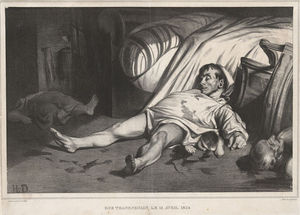Rue Transnonain le 15 de Avril 1834 Analysis
- Date of Creation:
- 1834
- Height (cm):
- 33.90
- Length (cm):
- 46.50
- Medium:
- Other
- Support:
- Other
- Subject:
- Scenery
- Art Movement:
- Realism
- Created by:
- Current Location:
- New Haven, Connecticut
- Displayed at:
- Yale University Art Gallery
- Owner:
- Yale University Art Gallery
- Rue Transnonain le 15 de Avril 1834 Analysis Page's Content
- Introduction
- Composition
Introduction
Daumier has often been praised for his "economy of means" - his lithographs are often sparse, but potent and in this case, haunting.
Daumier used the new technique of letting the facts stand alone, rather than inserting editorial commentary. This is one of Daumier's few lithographs that neglects satire entirely. In Rue Transnonain, le 15 de Avril 1834, Daumier shows that he is more than capable of adopting a serious tone as he lets the haunting aftermath of the police brutality that occurred on April 14th speak for itself.
Rue Transnonain le 15 de Avril 1834 Composition
The viewer's gaze is immediately drawn to the center of the painting. We are confronted with what appears to be a straightforward image of a man in nightclothes but then we notice that he is in fact tangled up in the bed linen. Although it is not immediately apparent, the dead man lies atop a dead baby. From the fact that her blood is thicker than his, the viewer deduces that the baby has been dead longer, which subtly adds to the horror.
The two bodies which lie on either side of the picture complement each other while the bed fills up the rest of the composition. Since beds symbolize rest and tranquility, its presence both detracts from the horror by neutralizing it and adds to it by placing the massacre within the common place.

